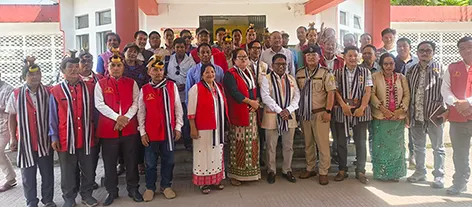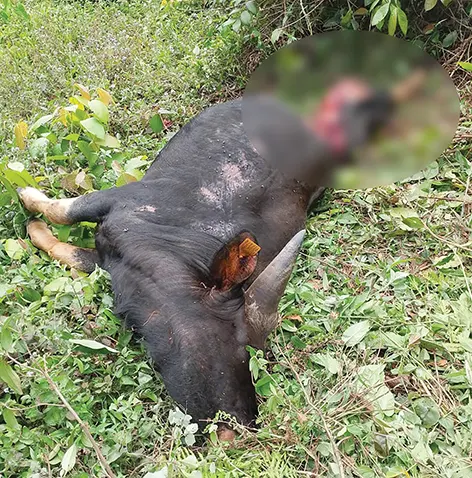[ Indu Chukhu ]
DOIMUKH, 2 May: The issue of wild dogs (dholes) attacking and killing mithuns is raising serious concern in Doimukh and nearby areas in Papum Pare district.
On Thursday, Papum Pare Deputy Commissioner Jiken Bomjen convened a meeting in Yupia with members of the Doimukh-Gumto Circle Mithun Farmers’ Club (DGCMFC) to address the alarming rise in mithun deaths caused, according to the mithun farmers, by wild dogs. Bomjen emphasised the urgent need to address the ecological balance causing such incidents.
“Smaller herbivorous animals are the primary preys for wild dogs. Now the wild dogs, which typically hunt in packs, are targetting the mithuns,” the DC said.
Recognising the cultural and economic importance of mithuns for tribal communities, the DC assured the mithun owners of his support in seeking compensation from the government. He encouraged them to follow proper channels and provide the necessary documentations for their claims.
During the meeting, DGCMFC chairman Chukhu Taje highlighted the economic and social significance of mithuns for unemployed villagers, and appealed for government’s assistance in securing compensation.
Chukhu also pointed out that the Forest Department has been rejecting compensation claims due to the lack of postmortem reports. He urged the government to relax these requirements, considering the challenges faced by villagers in remote areas.
“The population of wild dogs has increased significantly, while hunting of wildlife has been strictly prohibited due to various wildlife Acts and directives from the Forest Department,” Taje added.
He urged the Forest Department to devise measures to control the wild dog population.
The goan burahs present expressed frustration over the rising mithun deaths and the challenges they face in mediating between villagers and the government. They criticised the government for failing to protect villagers’ livestock despite its emphasis on wildlife conservation.
Yupia Senior Veterinary Officer Dr TR Nabam Hina proposed issuing postmortem reports or death certificates for mithuns based on photographic evidence and recommendations from the GBs and the Forest Department. He encouraged mithun owners to ear-tag their animals to prevent ownership disputes and simplify compensation claims.
Speaking to this reporter, Dr Hina said that most of the mithuns are dying due to food and mouth disease,and not necessarily due to wild dog attack. “Ten to fifteen percent of the compensation claims are not from valid mithun rearers,” he further informed, adding that “postmortem report is important to claim compensation, despite issuing a death certificate after seeing the photographic evidence.”
He informed that mithun carcasses beyond a month old are not taken into consideration for compensation claims.
Doimukh SDO Kipa Raja and Gumto CO Afa Phassang advised mithun owners to notify the district administration about mithun deaths, particularly those occurring near the Assam border. Referring to recent claims regarding mithuns dying after accidentally consuming herbicide at the Harmutty tea estate, they stressed the importance of refraining from prematurely concluding that poisoning is the cause of death.
Additionally, the officials emphasised the need to form committees at the circle level to recommend compensation-related matters to the government; to devise a uniform form for compensation across the departments; to implement geotagging of mithuns to avoid duplication of claims; and to explore the use of microchips to track mithuns effectively.
When contacted, Dr GV Gopi, senior scientist at the Wildlife Institute of India, Dehradun, said that Arunachal Pradesh is one of the few strongholds of surviving Asiatic wild dogs (dholes) population.
“With less than 2,500 mature individuals estimated in the wild, the World Conservation Union lists dholesas endangered, and they are accorded highest protection in India by the Indian Wildlife Protection Act by placing them in Schedule I,” Dr Gopi said.
“Livestock, especially mithun, is killed by large carnivores, including tiger and dholes in Arunachal,” he said.
Speaking on why mithun is an easy prey, Dr Gopi said that mithun being a free-ranging livestock is susceptible to predation by large carnivores,including dholes.
In February this year, the Forest Department increased the ex gratia amount for mithun deaths from Rs 10,000 to Rs 40,000. The ex gratia for one mithun calf killed in wildlife conflict is Rs 20,0000. The ex gratia amount is issued by the principal chief conservator of forests (wildlife), and the rate is fixed by the State Wildlife Board.
According to inputs received, farmers in many parts of the state have already received ex gratia amounts following wildlife-mithun conflict, while others are yet to receive it and have come to know about it only through social media platforms.
Currently the price of a mithun ranges from Rs 70,000 to Rs 1 lakh and above. The commercial price of mithun meat per kilo is Rs 700. On 1 September,2023, the Food Safety and Standards Authority of India (FSSAI) officially recognised mithun as a food animal.
While mithun rearers are anticipating compensation for their dead mithuns, it is learnt that many mithuns are also dying after consuming plastics and compensation is being claimed for such deaths too.



